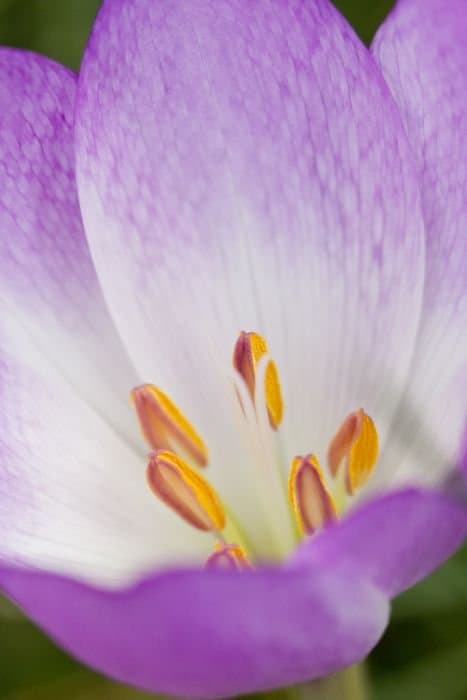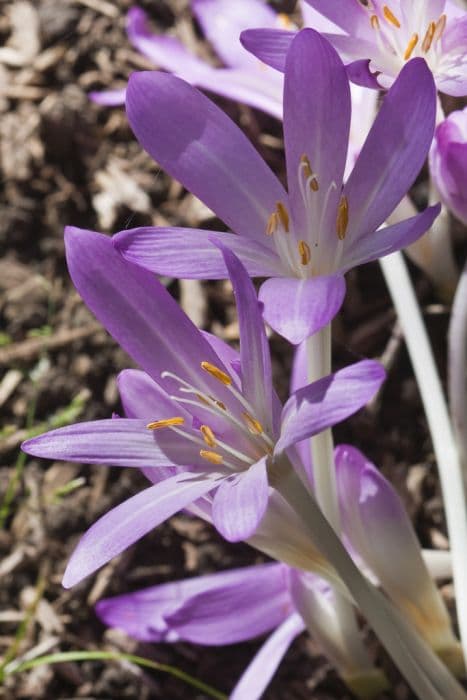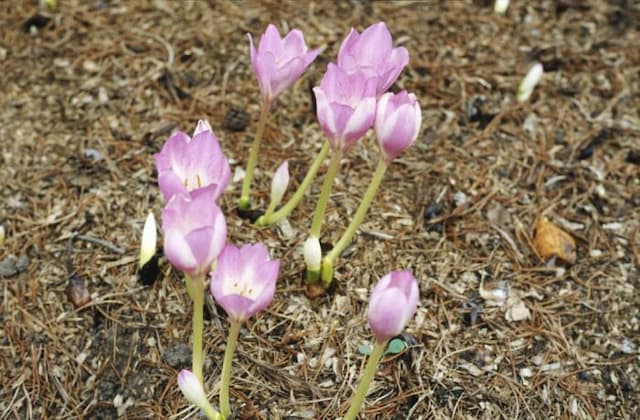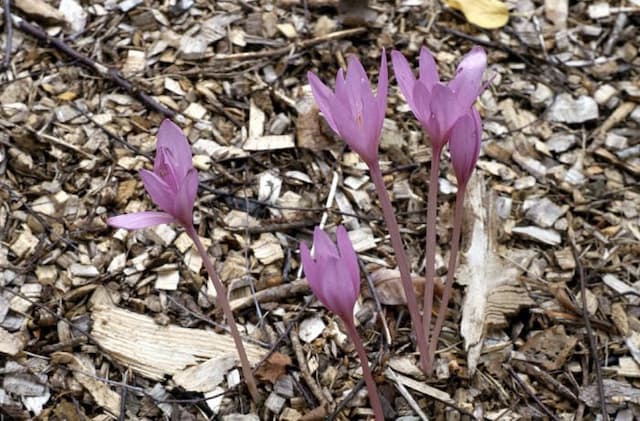Giant meadow saffron 'Album' Colchicum speciosum 'Album'

ABOUT
'Album' is a perennial to 15cm in height, with 1-3 green-throated, pure white flowers 6cm in length in autumn, followed by strap-shaped bright green leaves to 25cm in length
About this plant
 Names
NamesFamily
Colchicaceae
Synonyms
White Autumn Crocus, White Meadow Saffron, Album Autumn Crocus
Common names
Colchicum speciosum 'Album'.
 Characteristics
CharacteristicsLife cycle
Perennials
Foliage type
Deciduous
Color of leaves
Green
Flower color
White
Height
6 inches (15 cm)
Spread
3 inches (7.6 cm)
Plant type
Bulb
Hardiness zones
4
Native area
Middle East
Benefits
 General Benefits
General Benefits- Aesthetic Appeal: Adds beauty to gardens with its large, cup-shaped, white flowers that bloom in the fall.
- Naturalizing: Spreads over time to cover larger areas, creating a carpet of flowers when in bloom.
- Low Maintenance: Requires minimal care once established, making it suitable for busy gardeners.
- Drought Tolerance: Once established, it can withstand periods of dry weather without needing frequent watering.
- Deer Resistant: Rarely bothered by deer, which can help protect other plants in the garden.
- Pest Resistance: Generally resistant to common garden pests, reducing the need for chemical treatments.
- Seasonal Interest: Provides late-season interest in the garden when many other plants have finished blooming.
 Medical Properties
Medical Properties- Anti-inflammatory: Colchicum speciosum 'Album' is known to contain compounds that may exert anti-inflammatory effects.
- Analgesic: It has been used to alleviate pain in traditional medicine practices.
- Antirheumatic: The plant has been associated with treating symptoms of rheumatic conditions.
- Antigout: Colchicum speciosum 'Album', like other colchicum species, contains colchicine which has been used in the management of gout.
 Air-purifying Qualities
Air-purifying QualitiesThis plant is not specifically known for air purifying qualities.
 Other Uses
Other Uses- The Autumn Crocus can be used as a natural fabric dye, providing a source of dark yellow or brown hue depending on the mordant used.
- Garden enthusiasts sometimes plant Autumn Crocus as a means of deterring rodents due to its toxic nature, though with caution as it can be harmful to pets.
- In photography, the Autumn Crocus has been used as a subject for macro photography to showcase its intricate patterns and structures.
- The plant can be used in ecological studies to indicate soil health, as it may only grow in certain soil conditions.
- Autumn Crocus, due to its vibrant color and autumn blooming, is used to create a visual contrast in fall gardens against the typical reds and oranges of the season.
- Landscape designers often use the Autumn Crocus to create 'naturalized' areas in parks and large gardens by allowing it to spread and create a wildflower-like appearance.
- Culinary experimentation has seen the Autumn Crocus petals being crystallized as edible decorations, though great care must be taken because of its toxic alkaloids.
- The distinct bloom shape of Autumn Crocus provides inspiration for artists and designers, influencing patterns in textiles or motifs in jewelry.
- Because of its late flowering period, Autumn Crocus is used in educational settings to teach students about the growth and development of bulbous plants outside the typical spring cycle.
- Collectors of rare and unusual plants prize the Autumn Crocus 'Album' for its unique white flowers, adding it to their collections for display purposes.
Interesting Facts
 Feng Shui
Feng ShuiThe plant Autumn Crocus is not used in Feng Shui practice.
 Zodiac Sign Compitability
Zodiac Sign CompitabilityThe plant Autumn Crocus is not used in astrology practice.
 Plant Symbolism
Plant Symbolism- Endurance: The Colchicum speciosum 'Album', commonly known as Autumn Crocus, often symbolizes endurance due to its hardy nature and ability to survive in harsh conditions.
- Rebirth: As an autumn-blooming flower, it represents the idea of rebirth and new beginnings, relating to the cycle of life and seasons.
- Surprise: The Autumn Crocus is known for its sudden appearance above ground in the fall, symbolizing unexpected beauty or events.
- Caution: Due to the plant’s toxic attributes, it is often associated with caution or danger, reminding of the duality of nature’s gifts.
 Water
WaterThe Autumn Crocus should be watered sparingly during its growing season, typically in late summer and early fall, with a reduction in watering once the leaves die back. Allowing the soil to dry out slightly between waterings is recommended. When in active growth, watering every 7-14 days with about 16-32 ounces of water per session is usually sufficient, depending on the size of the pot and the environmental conditions. Ensure good drainage to avoid waterlogging, which can cause bulb rot. After the foliage has died back, watering should be reduced significantly to prevent the bulb from rotting during its dormant period.
 Light
LightAutumn Crocus thrives in conditions where it can receive partial to full sunlight. It's best planted in spots where it can enjoy the morning sun but is protected from the harsh afternoon light, as too much direct sunlight can damage the leaves and flowers. It is ideally situated in dappled shade underneath deciduous trees or on the east or north side of buildings where it can receive bright indirect light.
 Temperature
TemperatureAutumn Crocus prefers moderate temperatures and performs well in USDA hardiness zones 4 through 8, which dictate a minimum winter temperature range of 30 to -20 degrees Fahrenheit. The plant can survive temperatures down to around -10 degrees Fahrenheit, but ideally, it should be grown in an environment where the temperature remains between 50 and 70 degrees Fahrenheit during its bloom period in the fall.
 Pruning
PruningAutumn Crocus requires minimal pruning. Once the blooms have faded, you can cut back the flower stalks, but leave the foliage in place until it yellows and dies back naturally, as this helps the bulb store energy for the next growing season. Remove dead foliage in late spring or early summer. Pruning should be done annually, only when necessary, to maintain plant health.
 Cleaning
CleaningNot needed
 Soil
SoilAutumn crocus 'Album' thrives in a well-draining soil mix with added organic matter and a pH range of 6.0-7.0. A mixture of loam, peat, and sharp sand is ideal to ensure good drainage yet retain adequate moisture.
 Repotting
RepottingAutumn crocus 'Album' typically does not need frequent repotting. It can be repotted every 2-3 years or when it outgrows its container.
 Humidity & Misting
Humidity & MistingAutumn crocus 'Album' prefers moderate humidity but is quite tolerant of varying humidity levels, focusing more on proper soil moisture balance.
 Suitable locations
Suitable locationsIndoor
Place Autumn crocus 'Album' in bright, indirect light indoors.
Outdoor
Plant in part shade with well-draining soil outdoors.
Hardiness zone
4-9 USDA
 Life cycle
Life cycleColchicum speciosum 'Album', commonly known as White Autumn Crocus, starts its life cycle through the germination of its seeds in the soil, leading to the establishment of a corm, a type of bulb-like underground storage organ. The plant remains dormant over the winter, conserving energy in the corm. In the spring, foliage emerges, photosynthesizes, and stores energy before dying back in early summer. The corm remains dormant through the summer, and in autumn, without any leaves, it produces white, goblet-shaped flowers directly from the corm. After flowering, the plant sets seed, which disperses to give rise to new plants. The cycle repeats as the corm enters dormancy again in the winter, completing one full year of its life cycle.
 Propogation
PropogationPropogation time
Late summer to early fall
The most popular method of propagation for the plant known as Autumn Crocus 'Album' (Colchicum speciosum 'Album') is through dividing its corms. This is typically done in the summer when the plant is dormant. To propagate, carefully lift the clump of corms out of the ground and gently separate them, making sure each division has at least one growth point. Replant the corms immediately at a depth of about 3 to 4 inches (7.5 to 10 centimeters) and about 6 inches (15 centimeters) apart, in well-drained soil. Corm division is advantageous because it maintains the genetic consistency of the plant and allows for rapid increase in numbers.









